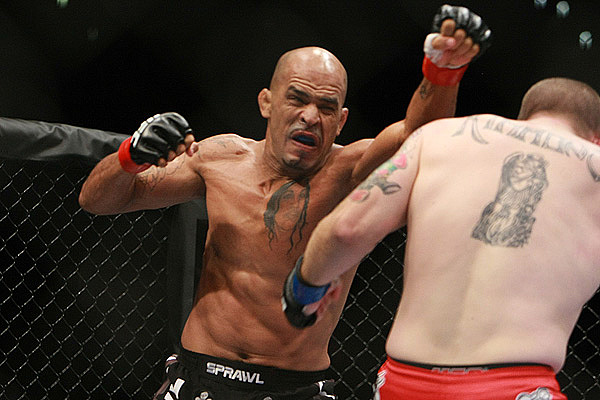Fighting on a Prayer
Returning to His Roots
Jack Encarnacao Nov 11, 2010

Jorge Rivera (top): Dave Mandel | Sherdog.com
Rivera found himself returning to his father’s example in August 2008, when his first child, Janessa, died at age 17 from a fatal reaction to birth control pills. Tears flow the instant her name is mentioned.
Advertisement
Rivera has not lost a fight since the death of his daughter, whose face is tattooed above his heart.
Loosening Up
For all the roles personal history and emotions play into Rivera’s tumultuous career, his recent renaissance can be attributed to an old-fashioned shake up in his fight preparation.
Following a narrow split decision win over Nissen Osterneck last April in which he badly fatigued down the stretch, Rivera broke from Mark DellaGrotte’s Team Sityodtong gym in search of a new approach. He began training under Peter Welch, who has worked with Kenny Florian and former UFC heavyweight champion Brock Lesnar. Rivera’s new overseers have changed his diet, kept him five pounds closer to his weight limit going into fights and stressed tempering his offensive volume.
“You want to harness that emotion; you don’t want that emotion to overwhelm you,” says Scott Rehm, Rivera’s strength and conditioning coach. “Trust me, you’re never going to get rid of it with this guy.”
That emotional fighting is part of what makes Rivera a safe bet for matchmakers looking for exciting matches and part of the reason UFC brass has granted him the last three opponents for which he has asked: Rob Kimmons, Nate Quarry and Sakara.
“I get my job,” Rivera says. “You’re in the business of entertainment. People want to see you lay it on the line. They want to see your heart. They want to see what you’re made of. They want to see what you’re about.”
The art comes in fighting this way without exposing oneself to the type of hit Martin landed on him in a moment of sloppiness. Trainer Derek Shea, an accomplished Boston boxer who fought on the same junior Olympic team as Oscar de la Hoya, believes Rivera will benefit from loosening up, sitting down more on his punches and minding the distance between his feet in his stance.
“MMA fighters on the whole, they have a problem with throwing their hands and being too tight,” Shea says, as he watches Rivera shadowbox. “You’ve got to be loose, fluid, just let your punches go. Instead of going out there and banging, set the guy up a little bit more.”
“
whole, they have a
problem with throwing
their hands and being
too tight.
”
Rivera appeared as composed as can be studying his footwork in a mirror inside Welch’s South Boston gym, his strides smooth and calm. After the Osterneck fight, he noted a tendency he has to hold his breath when throwing punches, which compromised his cardio.
“The biggest thing is how hard can you go, take a breath, recover and go that hard again,” Rehm says. “It’s basically trying to get his heart rate up as high as we can get it, killing him and having him slowing it right back down as quickly as possible and re-engage.”
Rivera’s also loosened up in terms of his personality. A series of online videos released this year by sponsor “Ranger Up” have added a dimension to how he is regarded.
In one series, Rivera offers 30-second comedic insights on life. In another, he dons a ludicrous, scraggly wig while singing 1980s pop hits with a troupe of costumed friends.
“This is a conclusion that I’ve come to in my life very recently,” Rivera says. “I don’t really care anymore, what people would think of me, how I may be perceived. Now, I just realize, man, I live this one time, and the people that I love most, I’ve got to make it a point that they know it and they get it and that they understand. At the end of the day, when it’s all said and done with for me, they’re the ones that I want to make an impression on.”
Related Articles







